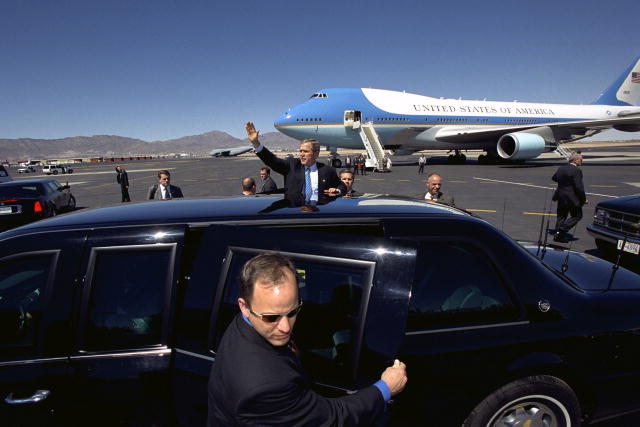In Wood v. Moss, 572 U.S. ____ (2014), Justice Ruth Bader Ginsburg wrote a decision for a unanimous Supreme Court deciding that Secret Service agents were entitled to qualified immunity for moving protestors away from President George W. Bush. Her decision also suggested that they had not engaged in viewpoint discrimination when they had done so.
Removed protestors said First Amendment rights were violated
The case grew out of an event that occurred in Jacksonville, Oregon, on October 14, 2004. Supporters and protestors had gathered across the street from one another for an appearance by President Bush, who was campaigning for a second term. After he unexpectedly altered plans for dinner, Secret Service Agents had cleared protestors who were within handgun or explosive range of the president, which put them somewhat farther away from the president than his supporters (whose line of sight to the president was obstructed by a building).
Although a district court had dismissed a case against the agents on the basis that they had qualified immunity, the Ninth U.S. Circuit Court of Appeals had found otherwise, and Ginsburg’s decision overturned this ruling.
Court: Secret Service agents who removed protestors entitled to qualified immunity
Ginsburg said that the Court assumed that federal agents were just as subject to claims for First Amendment violations as they would be for violations of the Fourth Amendment, as established in Bivens v. Six Unknown Fed. Narcotics Agents (1971). She further affirmed that “[i]t is uncontested and uncontestable that government officials may not exclude from public places persons engaged in peaceful expressive activity solely because the government actor fears, dislikes, or disagrees with the views those persons express.” Likewise, the government does not give individuals unlimited freedom to “publicize their views ‘whenever and however and wherever they please.’”
The doctrine of qualified immunity shielded agents from liability for actions that a reasonable officer would not have known to be a constitutional violation at the time. The Court had applied this standard in Hunter v. Bryant (1991). Moreover, prior decisions had recognized a strong interest in protecting the life of the president. Although the agents had moved protestors farther away than supporters, they had done so because only protestors were in the direct line of sight of the President.
Court saw valid security reason in protecting President Bush
Protestors pointed out that the agents had not removed all persons who were already at the Inn where Bush stopped to be removed, but Ginsburg noted that such individuals had no prior knowledge of the President’s stop and thus no opportunity to premediate harm to him. Moreover, it would be much easier to keep an eye on such a small group than on the larger group of protestors. Although protestors attempted to introduce evidence that agents had in the past exercised viewpoint discrimination, the agents clearly established that they had a valid security reason for doing what they had done in this case.
Consistent with the petition in this case, however, Ginsburg specifically limited the decision to the limited liability of the agents, which she upheld.
John Vile is a professor of political science and dean of the Honors College at Middle Tennessee State University. He is co-editor of the Encyclopedia of the First Amendment. This article was originally published in 2017.

